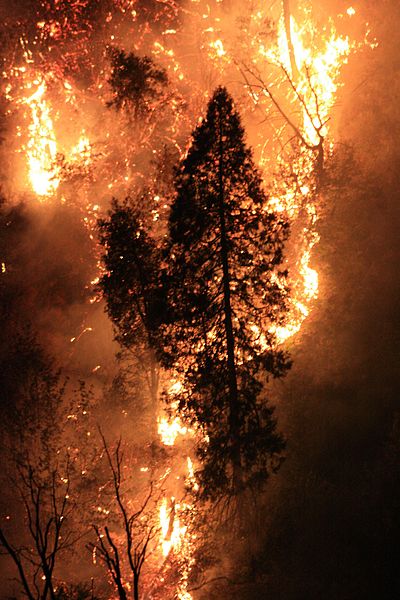Science News
Fire!
August 30, 2013
by Molly Michelson

Those of us who live in the western United States learn to expect forest fires as an unwelcome, annual occurrence. And, the Sierra Rim Fire is no exception. But the size, heat and proximity to Yosemite and Hetch-Hetchy have taken many of us by surprise.
We thought we’d highlight some of this week’s visuals and stories surrounding the blaze.
Videos
We’ve seen timelapses of fog, auroras, and the four seasons, so why not the Rim Fire as viewed from Yosemite National Park? It’s equally stunning.
This link was included in a blog post yesterday from Discover, with this astonishing fact about the fire that started on August 17:
It has now consumed 300 square miles — an area nearly two thirds as large as the sprawling City of Los Angeles — making the blaze the sixth largest in California history.
How about a bird’s-eye view of the blaze? Well, these videos posted by KQED News actually show us a pilot’s-eye view, courtesy of the National Guard.
From Space
Not high enough for you? NASA released images this week of the huge fire from two different satellites. One, from Suomi NPP, shows infrared images of the fire gaining ground over days. The other, from the Terra spacecraft, displays the trail of smoke the fire causes. The smoke can also be seen from the International Space Station, as seen in this image.
We found these images via the Bad Astronomer, who also posted this link on his site, where you can get up-to-date information about the fire, including a projected containment date of Friday, September 20th, 2013.
More images and numbers
National Geographic (of course) offers several beautiful and heartbreaking images from the ground. Their site also offers an article that provides some numbers from the fire: 4,000 firefighters fighting a fire that will be “20 percent contained by [this past] Wednesday” and “has involved 16 helicopters, 49 bulldozers, 454 fire engines, and 39 water tenders, wheeled tankers that transport water.” The same article explores the history of this type of large-scale firefighting.
Devastation
The large fire is burning through these wild lands, devastating wildlife along the way and wreaking havoc on the San Francisco’s water and electricity sources at Hetch-Hetchy. City and state officials have declared a state of emergency, reports the New Scientist.
Climate change
New Scientist also sees this as “a taste of things to come”:
Wildfires have always been a part of life in the US west, but they are on the rise as climate change takes hold. In California’s Sierra Nevada mountains, the main problem is the earlier onset of spring.
National Geographic echoes these sentiments, stating that fires this size might be the “new normal.” And a study by Harvard scientists, out this week, comes to the same conclusion. It suggests that because of our warming world, wildfire seasons will be about three weeks longer by 2050, up to twice as smoky, and will burn a wider area in the western states.
The aftermath
Finally, Brandon Keim at Wired offers a glimpse of what the landscape may look like post-fire, reminding us that fire is a “natural, inevitable phenomenon, and one to which western North American ecologies are well-adapted, and even require to sustain themselves.”
Image: US Department of Agriculture